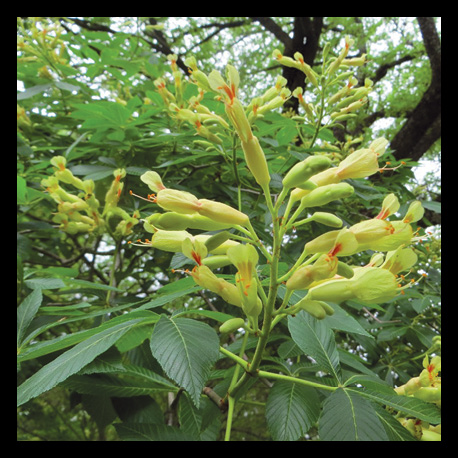Blooms of a Different Hue
We’re into novelty.
Novelty is fun. It is powerful. It stimulates the brain to wake up and take notice. A rocking chair? Nice. A giant rocking chair? “Boost me up and get the camera!” A teacup? Lovely. A tiny teacup? “Need! I’m going to plant the tiniest succulent in it!”
The delight we take in coming across the unexpected is something deeply rooted in our human brains. In our vital relationship to plants, keen attention paid by our ancestors to a novel individual or population has tremendously impacted modern human existence. Sweet, juicy corn? Much better suited for human consumption (and likely tastier) than the wild grasses it was cultivated from thousands of years ago. Paying attention to outliers can alert us to both danger and opportunity.
Let’s say you’re hiking along, casually scanning your surroundings, registering flora and fauna, keeping a mental tally of species you recognize. Something catches your attention: “Hey! I know that flower — but I’ve never seen it that color! A white spiderwort?! How cool! I wish the ones in my garden bloomed in that hue.” A study by Dr. Emrah Düzel of University College London supports the claim that this excited reaction to a novel observation is at least in part due to the production of dopamine in the reward and motivation part of the brain.
So does that mean flowers are popping up in atypical colors just to get our attention? Not likely. There are many genes and enzymes that determine pigment in a petal (or sepal or bract), and a mutation in any one of them could produce an odd-colored individual. Whenever I rush to Joe Marcus, one of our native plant experts (and this magazine’s plant information editor), with photographic evidence of a “new” discovery — a golden paintbrush (Castilleja indivisa) or cream-colored mountain laurel (Sophora secundiflora) — he offers the same response: “That’s due to a genetic mutation in an individual plant. It’s not at all uncommon.”
Marcus also notes that soil pH can affect flower color for some plants, Hydrangea macrophylla (a non-native species) being the most well-known. That may seem anticlimactic. “So I didn’t discover a unicorn bloom, just some rebellious genetic material?” But the truth is that even the most brilliant botanists don’t know why many genetic alterations or mutations occur in plants. There’s still much to be discovered about the mysterious world of plant DNA.
Even if you’re not a botanic geneticist, keep exploring. While happening upon a pink bluebonnet probably won’t have major implications for the future of food or medicine, if it leads you to pause and observe — if it activates your curiosity and makes you smile — that’s plenty special too.

Texas yellow buckeye PHOTO Minnette Marr
A Tale of Two Buckeyes
In some cases, differently colored blossoms may be markers of botanical variety. Take, for example, two varieties of red buckeye (Aesculus pavia). While the flowers of A. pavia var. pavia are blush to scarlet hued, A. pavia var. flavescens produces pale or bright yellow blossoms. Wildflower Center Conservation Program Manager Minnette Marr recalls that, in 2014, the Dawes Arboretum (in Newark, Ohio) requested our assistance in collecting capsules of the yellow-flowering variety, which occurs in the Texas Hill Country. Marr notes that it’s common for arboreta to focus on conserving a species through propagation when it has seeds that cannot be banked — and having representation from any existing varieties is ideal for diversity. Always ready to go the extra mile(s) in the name of conservation, Marr and Dr. Karen Clary collected fruit of A. pavia var. flavescens and overnighted it with ice packs to Dawes. Next time you head out to Hamilton Pool in spring (where and when they collected), why not go on an Aesculus scavenger hunt? The plants flower from March through May.

